What determines the yield of garlic and how to increase it: advice from experienced farmers and the nuances of growing
Garlic is a popular spicy vegetable crop among many peoples, relatively unpretentious, does not require serious financial investments, is in demand among the population and therefore, with proper agricultural technology, is very profitable.
In Russia, garlic has been known for a long time. In the ancient Russian annals of the 13th century, it is mentioned that our ancestors loved to drink wine, putting garlic in it. Under Tsar Alexei Mikhailovich in the middle of the 17th century, there were several pharmaceutical gardens for growing garlic.
A significant part of the garlic on the shelves of Russian grocery stores and retail chains is imported from China. It is cheaper than the domestic one and is well stored, but less "fenced off" than the Russian one and, according to experts, does not fully possess immunomodulatory and antibacterial properties.
The content of the article
What influences getting a high yield
The famous scientist, onion specialist, professor, doctor of agricultural sciences Suzan Vladimir Grigorievich notes that the most important thing when growing garlic is the choice of a variety adapted to the local conditions.
This culture does not like heavy soils. It is not recommended to plant it on heavy soils, since the husk is too dirty, poorly cleaned and the heads are stored worse.
In the absence of a choice, before planting, the soil is enriched with sand or expanded clay, peat and humus are added.
The culture loves a lot of sun, moderate moisture, fertile neutral soil, preferably sandy loam, into which manure with an acidity of pH 6.5 was introduced 2-3 years ago.
Another important condition for obtaining a rich harvest is the treatment of seed with a fungicide before planting. When planting seeds, the scheme is important, which will allow you to take care of the plants as efficiently as possible.When winter landing is mandatory feed the seedlings in the fall. The plant needs weeding (cultivation).
In dry weather, plantings are watered. Timely harvesting and its subsequent storage is of no small importance.
Garlic yield per hectare in Russia
Garlic is a fruitful crop, so novice businessmen love to cultivate it. What kind of crop do farmers collect from 1 are? According to statistics, from 90 to 300-500 kg or from 9 to 50 tons of bulbs (heads) are harvested from one hectare (ha).
Garlic has two varieties: winter and spring... They essentially differ in appearance, planting time, care. Winter crops, in comparison with spring crops, as a rule, give a higher yield, which is associated with cold resistance and the ability to use moisture obtained as a result of snow melting for growth.
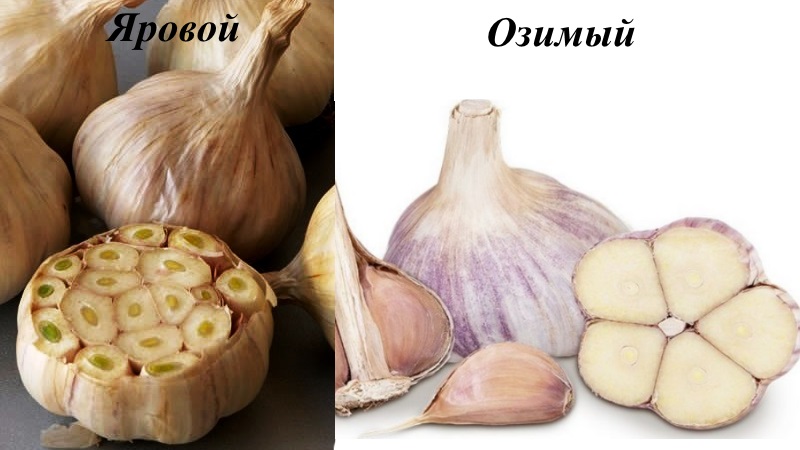
Winter
The winter crops are planted before winter 15-20 days before the first persistent frosts. It takes 8-9 months to develop. The bulb has a small number (4-10) of cloves adjacent to the stem (flower arrow). The average bulb mass is 50-60 g.
The bulbs drive out the flower arrows, on which airy bulbs (bulbs) are formed. If they are present, the mother bulb becomes smaller, the yield decreases. With large areas, garlic arrows are difficult to remove, so the cost of goods increases.
The most productive variety is considered Benefit - 35 tons per hectare.25 tons per hectare can be obtained by growing the variety Messido, 15-20 tons - Spas, 18 - Petrovsky and 11.5 tons per 1 hectare - Polessky souvenir.
Spring
Spring is planted in early spring (late March - early April), when the land still contains a lot of moisture, but is already warmed up to + 5-7 ° С. A spring garlic bulb fully ripens in 4-5 months. It contains a large number of denticles (12-30). Head weight - about 15-30 g.
As a rule, spring garlic is not arrowed, with the exception of the Gulliver variety. Subject to agrotechnical measures, high yields are achieved.
Spring garlic can be stored for a long time without loss of taste and useful properties - up to 2 years. Moreover, it can be stored at room temperature.
Of the spring varieties, the most productive variety is Aleisky. With proper cultivation, its yield reaches 14-16 tons of bulbs per hectare. The yield of varieties Sochi 56 and Strelets ranges from 7 to 12 tons per hectare, Pluto - from 7 to 9, and Yelenovsky - from 6 to 7 tons per hectare.
Is it profitable to grow for sale on a large scale
According to Professor VG Susan, there is a "gold mine" in garlic, but, unfortunately, not everyone can find it. Many farmers, judging by the reviews, derive considerable profits from growing this spice. In small areas, manual labor is quite possible. But what if you decide to plant a field of several hectares? Manual labor is not enough here - you need the help of special equipment.
Planting garlic with a seeder with a walk-behind tractor will significantly reduce material and time costs. Equipment is rented or bought. Some use equipment to plant other crops, such as tulips.
The benefits of the garlic business include:
- high profitability;
- minimum cash investment;
- constant and high demand for products.
Depending on the selected variety, 10-50 tons of vegetables are harvested from 1 hectare. Considering that 1 kg is sold at a wholesale price of 110 rubles, the minimum income will be 1.1 million rubles.
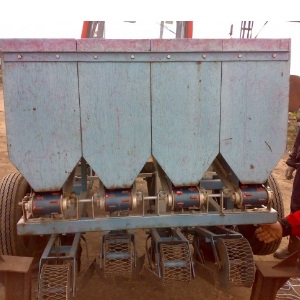 What expenses are required to grow 1 hectare of garlic?
What expenses are required to grow 1 hectare of garlic?
Approximately 540 thousand rubles:
- land lease - 5,000 rubles;
- purchase of planting material - 375 thousand rubles;
- fertilizers and utilities - 15 thousand rubles;
- equipment rental - 17 thousand rubles;
- purchase of inventory - 30 thousand rubles;
- workers' wages - 40 thousand rubles.
Now about the disadvantages. In case of failure with the sale of the goods, it is unlikely that it will be possible to feed the spice to livestock. Therefore, it is better to find buyers in advance, as soon as you decide to plant the field, and conclude a supply agreement with them.
Garlic buyers: food industry enterprises (sausage shops, canteens, cafes, etc.), vegetable stores, supermarkets.
Attention! With a successful choice of a variety, correct agricultural technology, and an established sales market, the profit pays for the costs in 1 year.
Cultivation technology on an industrial scale
First of all, you need to decide what kind of vegetable crop you want to grow - winter or spring? If you want to season dishes with garlic throughout the winter, plant a spring one, and if you are going to use it for canning vegetables for the winter, then a winter one is better. The difference between spring and winter crops is the timing of harvesting: the first is harvested in August - September, and the second - in late July - early August.
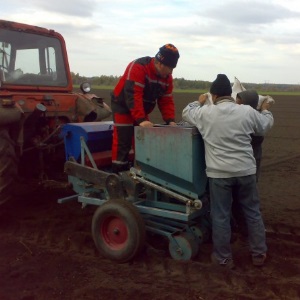 Winter garlic prefers sandy loamy soils, while spring garlic grows well on medium and light loamy soils. Spring varieties require more moisture and need systematic watering from early May to late June. Winter varieties are not so dependent on watering: the plant needs it, but even more - in loosening the row spacings. It should be started immediately after the soil in the garden stops sticking to shoes and tools.
Winter garlic prefers sandy loamy soils, while spring garlic grows well on medium and light loamy soils. Spring varieties require more moisture and need systematic watering from early May to late June. Winter varieties are not so dependent on watering: the plant needs it, but even more - in loosening the row spacings. It should be started immediately after the soil in the garden stops sticking to shoes and tools.
In Central Russia, it is most popular to grow winter forms of culture. For planting, use cloves (lateral buds) bulbs, one-toothed bulbs (sevok) grown from air bulbs, or air bulbs (bulbs).
Pay particular attention to the choice of seed. It must be zoned, adapted to grow in the given conditions.
It is also important to choose the right place for landing - open and sunny. Areas with close groundwater are not suitable for cultivation. It is not recommended to plant garlic where onions, carrots, cucumbers and tomatoes grew before it. Best predecessors: cabbage, legumes, pumpkin, squash, or greens.
So that the culture does not degenerate, in parallel with the commodity heads, 3-5 mm diameter bulbs are planted for growing cloves. At the same time, the seeding rate per 1 ha is 100-200 kg of bulbs. When growing from cloves, use the planting material of the first reproduction.
The teeth are planted in compliance with the planting scheme. The distance between the rows should be approximately 20 cm, between the plants - 10-15 cm, the embedding depth - 5-7 cm.
Attention!When choosing a planting scheme, consider how convenient it will be to use the equipment (tractor, cultivator).
Before planting, the seed is carefully inspected for damage, treated with fungicides to avoid decay. The bottom of the furrows is sprinkled with sand and ash, and the top with earth.
The timing of planting a vegetable depends on the type chosen: winter varieties are planted in the fall, 3-4 weeks before the first frost, and spring varieties - in April, when the soil warms up to + 5-7 ° С.
Ideally, soil layers, starting at 3 cm and further down to 30-35 cm, are taken for analysis. Before sowing, the soil should contain at least 20 mg of nitrogen, 20-25 mg of phosphorus and 25-30 mg of potassium in terms of 1 kg of soil.
Regardless of the timing of planting in early September, the soil is dug up, cleaned of weeds and debris, and then the following fertilizers are applied: 1 bucket of humus, 50-60 g of superphosphate, 50-60 g of ammonium nitrate.
A rich harvest means timely watering, weeding, cultivation, feeding. In the spring, when the first leaves appear, nitrogen fertilizers, for example, urea, are added to the soil. After 15-20 days, complex mineral fertilizers are applied. When 5-6 leaves appear, the soil is enriched with phosphorus-potassium additives. Watering the plantings is stopped 2-3 weeks before harvesting.
The crop is harvested when the leaves of the plant turn yellow and dry (the lower ones are dry, and the upper ones are yellowed), the leaves lean to the ground, the shells of the air onions crack.
Harvesting is usually done by hand. The bulbs are immediately cleared of soil and left to dry for 20 days at a temperature of + 25-30 ° C. Then the roots and leaves are cut, the neck is shortened to a length of 2-5 cm.
The crop is stored in a dry and cool room with a humidity of no more than 80%.
Growing and marketing garlic as a business idea:
Ways to increase yields
The key to a high yield is correct agricultural technology. You should start with the correct fit. It is important to plant not early or late, but on time. Mandatory pre-treatment of the seed with a fungicide, for example, "Fundazol", to protect plants from root rot.
It is necessary to plant the bottom down. Cut or break off arrows in arrow varieties. Timely watering, fertilizing, loosening, weeding also significantly increase the yield.
Non-chemical methods of increasing the yield of garlic
Garlic doesn't like heavy soils. Loamy and sandy loam soils are suitable for its cultivation. To increase the crop yield, the structural composition of the soil is improved with sand, peat, loam, depending on the original characteristics.
Note that acidic soil needs to be limed, as the optimum pH is in the 6.5-7.9 range.
The soil for sowing is prepared immediately after the harvest: plant residues are removed, shovels are dug onto a bayonet, sown with siderates (mustard, lupine, etc.). Compost or dry humus is used as organic fertilizers.
To avoid the use of herbicides, special equipment is used for weeding - cultivators.
Attention! You cannot fertilize with fresh manure.
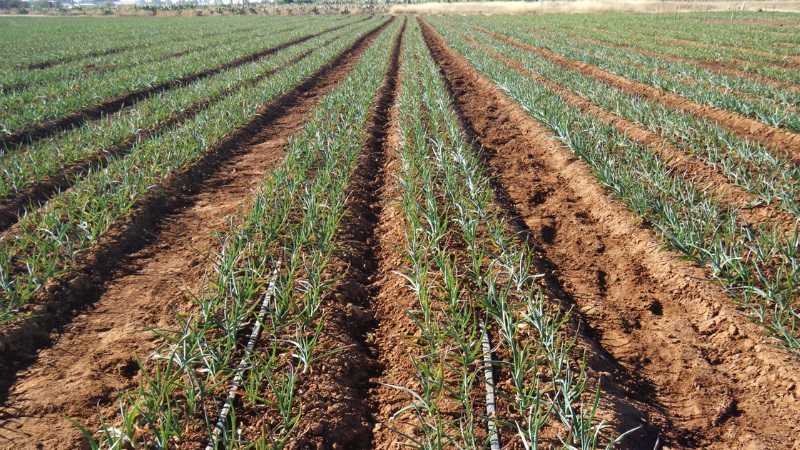
Influence of the region
Areas with high snow cover and mild winters are suitable for growing garlic. It is better to grow spring varieties of garlic where summer lasts 3-4 months. Keep in mind that the yield of winter garlic is higher than that of spring garlic, but keeping quality is much lower.
Garlic is grown in all regions of Russia. Withdrawn varieties for growing in Siberia, the Urals, in the Moscow region.
Winter garlic is most often grown in Russia. The choice of variety depends on the region:
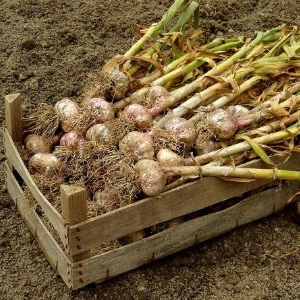 In the southern regions, Ukrainian varieties are popular: Lyubasha, Ukrainian white and Ukrainian purple. The following varieties are popular: the long-stored and fruitful Spas, the Dutch Messidor, the medium-late long-stored Gulliver and the unpretentious Romanian Benefis.
In the southern regions, Ukrainian varieties are popular: Lyubasha, Ukrainian white and Ukrainian purple. The following varieties are popular: the long-stored and fruitful Spas, the Dutch Messidor, the medium-late long-stored Gulliver and the unpretentious Romanian Benefis.- The best for cultivation in Siberia are recognized: mid-season Gribovsky Yubileiny, frost-resistant Yelenovsky, Spas (heads up to 100 g).
- For the Urals, a region with hot summers and frosty winters, the following are most suitable: Scythian, Bashkir 85, Sofievsky and early ripe Dobrynya.
- In the Moscow region, the following varieties have shown themselves well: Moscow Region, Union, Komsomolets, Nadezhny, Zubrenok.
However, the yield depends not only on the choice of the variety, but also on the correct planting dates, soil conditions, irrigation and fertilizing. So, if you plant, for example, winter garlic too early, it will rise even before the onset of cold weather and die.
Care rules for a rich harvest
How to care for garlic for a rich harvest? This question is often asked by novice farmers. Spain and Israel are recognized as world leaders in the production of garlic. Israeli agronomist Eyal Cohen advises planting 260 thousand cloves per hectare, and certainly bottom down. Pre-treatment of seed is required.
Garlic is sensitive to daylight hours. It is often for this reason, other things being equal, that the variety is good in some regions, but does not yield in others.
Council. Start with a few varieties, planting them in small areas, and choose the most suitable.
If the soil is too acidic, dolomite flour or slaked lime is added to it, thereby reducing the acidity.
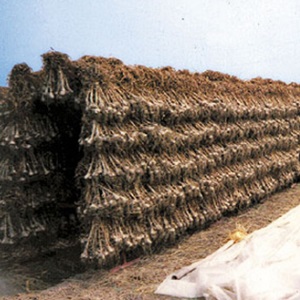 Fertilizers are applied in the fall, during digging of the soil, after all predecessors are removed from the garden. It is desirable that nutrients can penetrate into the ground at least on the bayonet of the shovel.
Fertilizers are applied in the fall, during digging of the soil, after all predecessors are removed from the garden. It is desirable that nutrients can penetrate into the ground at least on the bayonet of the shovel.
When watering, follow the rule: the top 30 cm of soil should be moist, especially during the bulb formation phase and until the end of bulb growth. After the bulb has reached the desired size, watering and fertilization are completely stopped.
The best yield is obtained on loamy soil, where the acidity is low or optimal. Moreover, the more fertilizers based on organic matter and minerals are introduced into the soil, the higher the yields.
Compliance crop rotation - an important point that affects the productivity of the culture. It is best to plant garlic after legumes, cabbage and melons (zucchini, eggplant, pumpkin), as well as after siderates.
When buying material for planting, decide whether you will grow the winter or spring form of the crop. In the first case, the bulbs grow strong and large, and in the second, the harvest is stored longer.
As a planting material, cloves or one-toothed teeth are used, which were obtained when growing a bulb from a garlic arrow.
You can not plant the teeth in the ground, which is exposed to the accumulation of melt water and precipitation. It is also desirable that the groundwater is far from the landing site. The key to obtaining high yields is the removal of flower arrows longer than 10 cm at a certain time.
Garlic, like other vegetables, is damaged by pests and various diseases. To grow healthy bulbs, before planting, prophylaxis of seed material is carried out with solutions of copper sulfate, tar soap, "Fundazol".
One of the most insidious pests that sometimes ruins the entire crop is the stem nematode. She lays eggs in the bottoms of the bulbs. Nematodes overwinter in the plant or in the soil, preferring heavy, clayey ones. In dry plants, the pest persists for more than 4 years under favorable conditions.
Diseases of garlic. Advice from Professor V.G.Suzan:
Farmers reviews
Reviews of farmers about the prospects for growing garlic are different. Among them there are negative ones, but more positive ones.
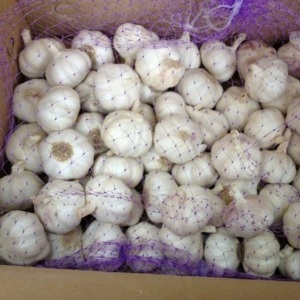 Farmer with the nickname "Stranger V" (Kaliningrad, Russia):“I grew garlic for a couple of years, but I gave it up - a difficult and thankless culture.”
Farmer with the nickname "Stranger V" (Kaliningrad, Russia):“I grew garlic for a couple of years, but I gave it up - a difficult and thankless culture.”
Vitalka1988 (Volgograd region):“I decided to sell the bulk of the goods in bulk, in Volgograd. I handed in garlic in various batches at a price of 90 to 100 rubles per kilogram ... My wife also sold on the market, sometimes in larger batches, and sometimes at retail. I gave it to the sausage shop, to the bakery. My fellow villagers turned to me for a product, knowing that the product was of high quality and environmentally friendly ... At the end of summer, people are just getting ready for the long winter, making all kinds of canned food and twists that contain garlic, so the demand is great. Taking into account all the expenses, in the first year garlic brought me a considerable income - more than 17,000 rubles a month. And the next year, by increasing the area and correcting some details, I developed my business to an even greater scale in terms of earnings. "
Anna Guzovskaya (Krasnodar Territory): “In Russia, production does not compensate for all the needs of the domestic consumer. Therefore, most of it is imported from China. Such garlic has many disadvantages, since the quality and shelf life are significantly inferior to our garlic. Renting 1 hectare of land, you can have 5-10 tons of crops. And this is 1 million rubles. In addition, if you organize the lease of large areas of land, you must find contact persons in advance, conclude a supply agreement with them. After that, you can safely start planting garlic! "
Sergey Alekseevich (Orenburg region): "Garlic is a good way to earn money, it does not require large initial investments, you need to work with it 10-20 days a year (depending on what kind of garden you have), it pays off in the very first year."
Conclusion
Growing garlic is a profitable business, interesting, but subtle, with many nuances. Variety selection and farming techniques vary greatly depending on the growing region.
Calculation, contact with experienced farmers, pre-establishment of a sales market will help to avoid unforeseen financial losses and recoup the cost of purchasing (renting) land, special equipment, and seed in 1 year.
In the video below, Professor Susan's advice on growing garlic as a business: